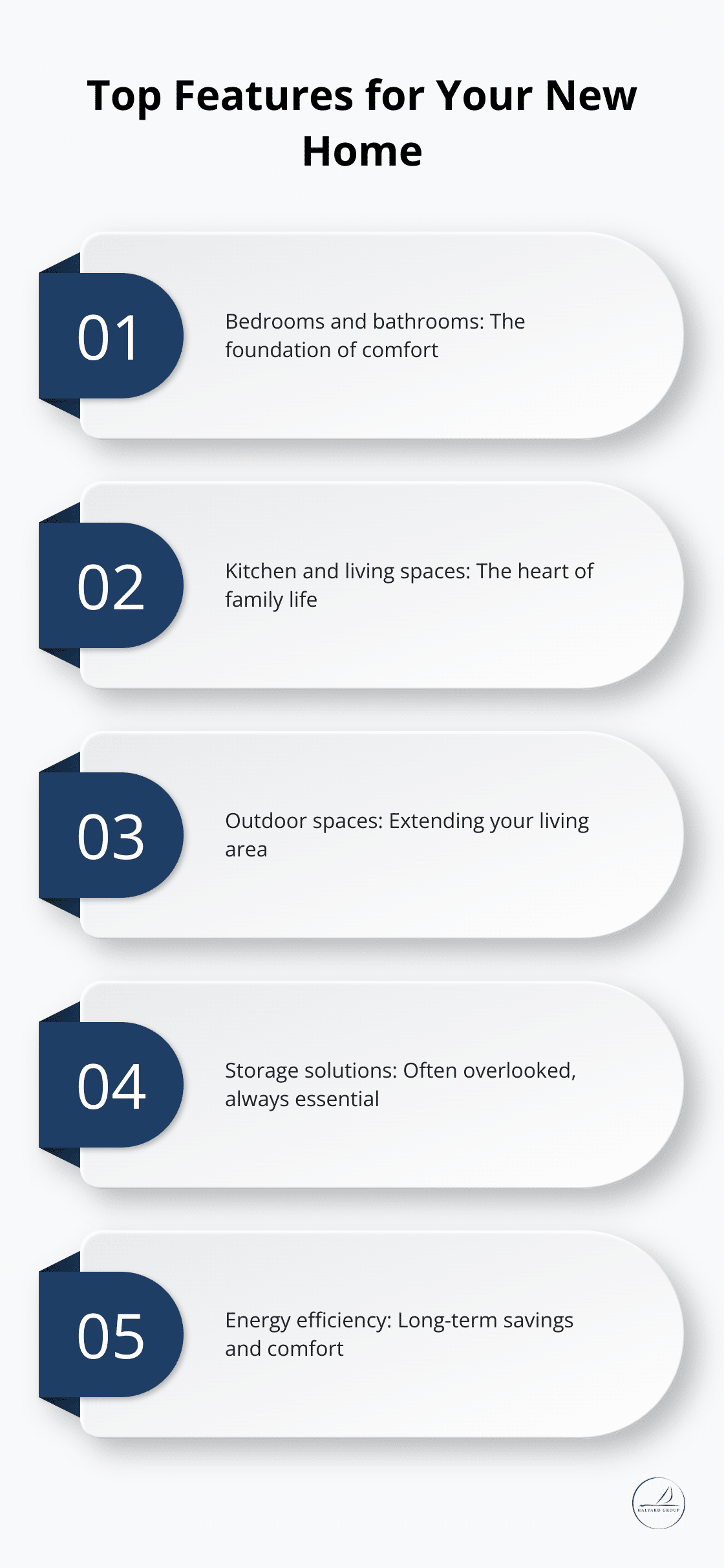Are you ready to find your dream home? Creating a comprehensive home wishlist is the first step towards finding the perfect larger space for your family.
At The Halyard Group, we understand that every family’s needs are unique. This guide will help you craft a tailored wishlist that captures your must-haves, preferences, and future aspirations for your new home.
What Your Family Really Needs
Space Crunch Analysis
Take a hard look at your current living situation. Do you trip over toys in the living room? Is your kitchen too small for family meal prep? Do you lack a dedicated home office space?
List these pain points. This exercise will help you identify what doesn’t work in your current home and guide your search for a more suitable living space. Predictive analysis can help agents forecast market trends, identify potential buyers and sellers, set competitive prices, and make strategic business decisions.
Must-Have Features
Focus on the non-negotiables. These are the features your new home absolutely must have to accommodate your family’s lifestyle. You might need a minimum of four bedrooms to give each child their own space. Or perhaps a large, open-concept kitchen is essential for your family’s love of cooking and entertaining. Don’t underestimate the importance of ample closet space or a garage for storing seasonal items (many families often overlook these crucial storage needs).
Future-Proofing Your Home
Think beyond your current needs when you create your wishlist.
A study by the National Association of Realtors shows that the average homeowner stays in their home for 13 years. That’s a long time for life changes to occur. Do you plan to expand your family? Will you need space for aging parents in the future? You might consider a career change that would require a home office. Factor these potential changes into your wishlist to ensure your new home can adapt to your evolving lifestyle.

Expert Guidance
The Halyard Group has helped numerous families in the Greater Toronto Area find homes that not only meet their current needs but also accommodate future growth. Our expertise in the local market allows us to guide you towards neighbourhoods and properties that align with your long-term goals.
Creating a comprehensive wishlist requires you to balance your immediate needs with your future aspirations. A thorough assessment of your current challenges, identification of must-have features, and consideration of potential life changes will equip you to find a home that truly fits your family’s unique needs. Now that you’ve identified your family’s needs, let’s move on to prioritizing specific home features that will make your new space truly feel like home.
What Features Matter Most in Your New Home?
Bedrooms and Bathrooms: The Foundation of Comfort
The number of bedrooms and bathrooms in your new home forms the cornerstone of comfort. The National Association of Home Builders reports that the average new single-family home in 2022 had 3.0 bedrooms and 2.4 bathrooms. Your family’s needs, however, might differ.
Consider not just your current situation but future needs as well. If you plan to expand your family or potentially host extended family members, an extra bedroom or two can prove invaluable. For bathrooms, try to have at least one full bathroom for every two bedrooms, plus a powder room for guests.
Kitchen and Living Spaces: The Heart of Family Life
The kitchen and living areas serve as the hub of family life. Open-concept layouts have surged in popularity for good reason – they promote a sense of openness and greater traffic flow. When you evaluate these spaces, think about your family’s habits. Do you need a large island for casual meals or homework sessions? Is a separate dining room important for formal occasions? For living areas, assess the flow between spaces and whether there’s enough room for everyone to gather comfortably.
Outdoor Spaces: Extending Your Living Area
Don’t underestimate the importance of outdoor spaces. A study by the National Association of Realtors found that 97 percent of REALTORS® agree that potential buyers find curb appeal important, with 66 percent saying that buyers tend to rank it as very important. For your new home, consider how you’ll use outdoor spaces. Do you need a large backyard for children to play? Would you enjoy a patio for al fresco dining? Perhaps a garden for growing your own vegetables is on your wishlist. Outdoor spaces can significantly enhance your quality of life and add value to your property.
Storage Solutions: Often Overlooked, Always Essential
Storage often falls by the wayside when house hunting, but it’s a feature that can make or break your daily life. Ample closet space, a garage, or a basement can provide the storage you need for seasonal items, sports equipment, and those “just in case” possessions. Consider built-in storage options like window seats with hidden compartments or under-stair storage to maximize space efficiency.
Energy Efficiency: Long-term Savings and Comfort
Energy-efficient features might not be the first thing on your mind, but they can significantly impact your comfort and wallet in the long run. Look for homes with energy-efficient windows, well-insulated walls, and modern HVAC systems. Ultra-efficient homes combine state-of-the-art energy-efficient construction, appliances, and lighting with commercially available renewable energy systems. These features can lead to lower utility bills and a more comfortable living environment year-round.

As you prioritize these features, balance your must-haves with your nice-to-haves. Focus on the elements that will truly enhance your family’s lifestyle in your new, larger home. Your next step? Consider the location factors that will complement these home features and support your family’s daily life and long-term goals.
Where Should Your New Home Be Located?
School Districts: A Key Factor for Families
Families with school-age children (or those planning to have children) should prioritize research on school districts. A recent study shows that Gen Z buyers and sellers aged 18 to 25 made up just three percent of buyers and two percent of sellers. Check school ratings on websites like GreatSchools.org or Niche.com for insights into academic performance, teacher quality, and parent reviews.
Don’t limit your research to elementary schools; consider the entire K-12 pathway. A neighbourhood with excellent elementary schools but subpar high schools might not serve your long-term needs. Investigate special programs or extracurricular activities that align with your children’s interests or needs. You can view in-depth guides on many GTA neighbourhoods here.
Commute Times: Work-Life Balance
Your daily commute can significantly impact your quality of life. Recent data shows the average commuter spends around 25.6 minutes on the way to work each day. Decide how much time you want to spend traveling each day and factor this into your location choice.

Use tools like Google Maps to check commute times during rush hour from potential neighbourhoods to your workplace. Explore public transportation options if available. Some areas might offer express buses or train services that could make a longer distance more manageable.
Community Features: Life Beyond Your Front Door
Neighbourhood amenities and features can greatly enhance your lifestyle. Parks, libraries, community centers, and local shops all contribute to the overall living experience. A 2023 Pew survey found that 42% of respondents would prefer a community with smaller homes but walkable amenities.
Visit potential neighbourhoods at different times of the day and week to experience the community vibe. Look for sidewalks for evening strolls and observe if families are out and about. These observations will provide valuable insights into daily life in the area.
Safety and Security: Peace of Mind
Safety should rank high on your list of priorities when choosing a location. Research crime rates in potential neighbourhoods, and pay attention to the presence of street lighting, neighbourhood watch programs, and the overall upkeep of the area, as these factors often correlate with safety.
Future Development: Long-Term Outlook
Consider the future development plans for the areas you’re interested in. Research local zoning laws and upcoming construction projects. A neighbourhood that’s currently quiet might transform significantly in a few years due to new commercial or residential developments. This information can help you make a more informed decision about the long-term suitability of a location for your family.
Final Thoughts
A home wishlist serves as a roadmap to your family’s future. The perfect home might not check every box, but it could still fit your family well. We recommend flexibility in the home search process while standing firm on your must-haves.
The Halyard Group specializes in helping families in the Greater Toronto Area find their ideal larger homes. Our personalized approach and understanding of the local market allow us to guide you through every step of the process. We strive to ensure a seamless transition for your family.
Your home wishlist is more than just a checklist. Taking the time to create a comprehensive wishlist and partnering with experienced professionals sets you up for success. We can help you turn your home wishlist into reality and find the perfect larger home for your family’s next chapter – get in touch today if you’d like to have a no obligation chat about your family’s needs.





